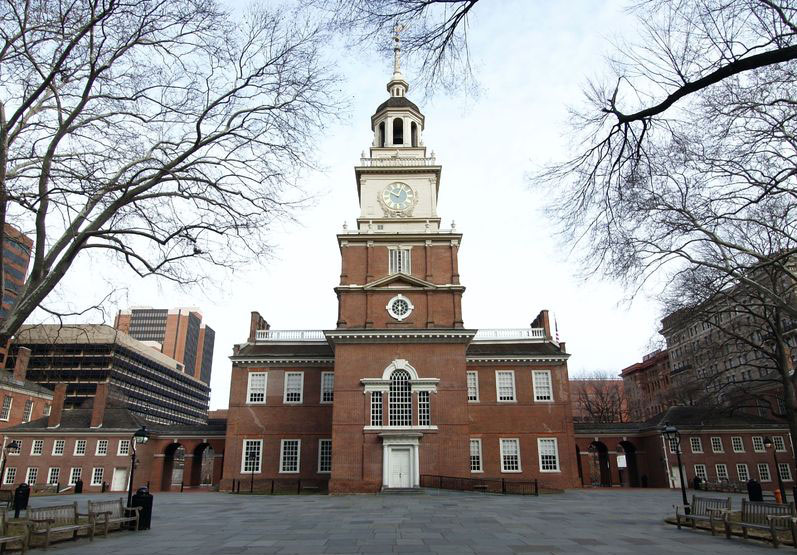
Independence Hall in the Independence National Historical Park. Photo © klotz/123rf.
Independence Hall is the centerpiece of Independence National Historical Park. Just in case you slept through grade-school history classes, this is where the Declaration of Independence and the Constitution were debated, drafted, and signed, and where the United States’ independence from England became official. The principles that our nation was founded on were formed inside these walls. Independence Hall is actually the center of a trio of matching Georgian buildings that housed the three branches of early government, and it makes sense to visit all of them together.Originally called the State House, the classic Georgian structure was designed by Andrew Hamilton and Edmund Wooley and built in 1732-1756. Of the many restorations it has undergone, the most notable were those by Greek Revival architect John Havilland in 1830 and by the National Park Service in 1950; the latter greatly restored the building to its late 18th-century appearance. The furniture is largely reproduction pieces, since most of the original furniture was burnt during the winter of 1777-1778 when Philadelphia was briefly occupied by the British Army.Independence Hall was the meeting place for the Second Continental Congress in 1775-1783, except during that brief British occupation. The most important decisions were made in the 1st-floor Assembly Room, home to George Washington’s famous “Rising Sun” chair. This is where he was appointed commander in chief of the Continental Army (1775), the Declaration of Independence was adopted (July 4, 1776), the design of the American flag was agreed upon (1777), the Articles of Confederation were adopted (1781), and the U.S. Constitution was drafted (1787). Original copies of the Articles of Confederation, Declaration of Independence, and the Constitution are on display in the Great Essentials Exhibit in the West Wing. You can also see the Syng silver inkstand that the founding fathers dipped their ink into to sign the Declaration of Independence and the Constitution.
Independence Hall is actually the center of a trio of matching Georgian buildings that housed the three branches of early government, and it makes sense to visit all of them together. On the corner of Chestnut and 5th Streets sits Old City Hall. Built in 1790 by master carpenter David Evans, it was home to the United States Supreme Court 1791-1800. Once the capital moved to D.C., this building became Philadelphia’s City Hall until 1870.
On the corner of Chestnut and 6th Streets is Congress Hall, where the two branches of Congress met (1790-1800). The House of Representatives was on the 1st floor and the Senate on the 2nd floor. Built in 1787, Congress Hall was the site of the presidential inaugurations of George Washington (second term) and John Adams. It is also where the Bill of Rights was ratified. On the 2nd floor, there are many symbolic designs, including a 19th-century fresco of an eagle holding an olive branch signifying peace and a plaster medallion on the ceiling with an oval sunburst with 13 stars to honor the 13 original states. The carpet features 13 state shields and cornucopias wishing for abundance in the new land, and is a reproduction of the original made in the 1790s by William Sprague, who was founder of the first woven carpet mill in Philadelphia, credited with bringing the carpet industry to the United States.
Indepedence Hall is located on Chestnut St. between 5th and 6th Sts. (877/444-6777; daily 9am-5pm; tours start every 15-30 minutes, last tour at 4:30pm; free, timed-ticket required Mar.-Dec., reserve at Independence Visitor Center the day of visit (tickets go fast in summer so come early) or in advance online or by phone ($1.50 charge))×Excerpted from the Third Edition of Moon Philadelphia.